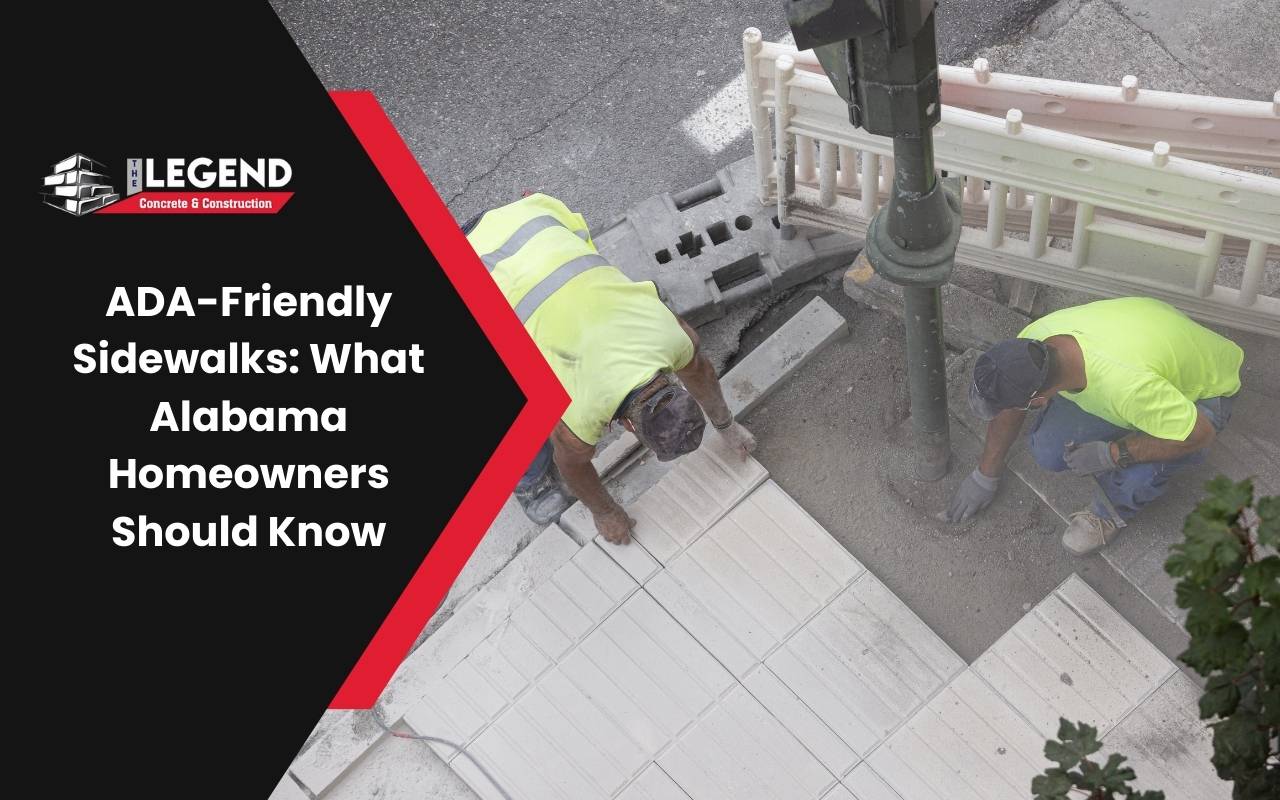
For many Alabama homeowners, following the Americans with Disabilities Act might feel overwhelming. However, compliance with ADA sidewalk guidelines Alabama creates safer and more inclusive neighborhoods. Key requirements like cross slope, detectable warnings, and clear width help everyone navigate comfortably. Accessible sidewalks are not only legally necessary but also socially responsible, improving community well-being.
Understanding the Americans with Disabilities Act (ADA) Guidelines
The ADA, enacted in 1990, prohibits discrimination against individuals with disabilities. It covers public and private facilities, including sidewalks. Local governments and homeowners in Alabama must meet ADA sidewalk guidelines Alabama to remain compliant. These rules specify slope, tactile indicators, and surface texture. Therefore, compliance ensures equal mobility access and fosters inclusion. Homeowners who understand these rules can take meaningful steps toward accessibility.
Importance of ADA-Friendly Sidewalks for Alabama Homeowners
- Improve safety for all residents and visitors.
- Reduce risks of accidents or liability issues.
- Enhance property value and neighborhood reputation.
Ignoring them can lead to penalties or lawsuits. Beyond legal risks, there is also an ethical responsibility. Accessible sidewalks allow wheelchair users, seniors, and families with strollers to travel independently. Moreover, a focus on accessibility shows that homeowners value dignity and equal opportunity for everyone.
Key Elements of ADA Sidewalk Guidelines
Compliance with ADA sidewalk guidelines Alabama involves several design criteria. Each element, from slope to tactile indicators, ensures usability for all pedestrians. These requirements consequently reduce obstacles, improve safety, and promote independence for individuals with disabilities.
Implementing the Cross Slope Requirement
The ADA mandates a maximum 2% cross slope for pedestrian routes. This angle balances drainage needs and mobility safety. A slope greater than 2% may cause tipping risks, while proper grading ensures stability. Routine inspections confirm sidewalks remain compliant with ADA sidewalk guidelines Alabama. Accurate measurements and careful construction therefore help achieve lasting compliance.
Installing Detectable Warnings on Sidewalks
Detectable warnings, such as truncated domes, alert individuals with vision impairments to hazards. These textured surfaces must be at least 24 inches deep and span the ramp width. Under ADA sidewalk guidelines Alabama, they must contrast in color, remain securely installed, and follow precise spacing standards. Correct placement ensures independent, safe travel for people with low vision.
Ensuring Clear Width for Accessibility
ADA rules require sidewalks to maintain a clear width of at least 36 inches, or 48 inches at passing spaces. Wider paths support safe two-way traffic. Obstructions such as poles, planters, or overgrown vegetation reduce accessibility. Regular monitoring ensures pathways meet ADA sidewalk guidelines Alabama requirements. Consequently, clear, unobstructed sidewalks create safe passage for all users.
Benefits of Creating Inclusive Sidewalks in Alabama
- Encourage healthier, more walkable communities.
- Support local businesses through improved access.
- Strengthen social connections and civic pride.
When neighborhoods prioritize accessibility, everyone benefits. Families, seniors, and visitors experience smoother travel. Moreover, communities with accessible sidewalks demonstrate care for public welfare. Small improvements can inspire broader investments, such as better lighting or landscaping, fostering shared progress.
Maintaining ADA-Friendly Sidewalks: Best Practices
Routine maintenance preserves compliance. Seasonal changes and heavy use can cause cracks, uneven slopes, or worn tactile surfaces. Therefore, best practices include trimming vegetation, repairing cracks, and inspecting slopes annually. Documenting these tasks shows responsibility and commitment. Adhering to ADA sidewalk guidelines Alabama ensures long-term accessibility and safety.
FAQs about ADA Sidewalk Guidelines in Alabama
What does ADA stand for?
ADA means Americans with Disabilities Act, a law promoting equal access in public spaces, including sidewalks.
Why are ADA sidewalk guidelines Alabama important for homeowners?
They help ensure sidewalks are safe, accessible, and legally compliant, protecting homeowners from liability risks.
How wide should sidewalks be under ADA rules?
Sidewalks should be at least 36 inches wide, with 48 inches for passing spaces where necessary.
Do detectable warnings need specific colors?
Yes, they must contrast visually with surrounding surfaces and provide tactile cues for safety.
Who can help homeowners follow ADA guidelines?
Experienced contractors and accessibility professionals can design and maintain sidewalks to ensure compliance.
Partnering with Professionals for ADA Sidewalk Compliance
- Review credentials and request references before hiring.
- Ensure contractors understand federal and state requirements.
- Rely on expert assessments to avoid costly errors.
Working with certified specialists simplifies compliance. Professionals know how to measure cross slope, install tactile warnings, and maintain proper widths. Their guidance ensures sidewalks align with ADA sidewalk guidelines Alabama. For assistance, you can contact Legend Concrete Construction today.
Enhancing Accessibility and Community Through ADA-Friendly Sidewalks
Investing in accessible sidewalks demonstrates social responsibility. Alabama homeowners who embrace these principles build safer, more welcoming neighborhoods. Compliance with ADA sidewalk guidelines Alabama creates lasting benefits for residents and visitors. Accessibility, maintenance, and professional collaboration together foster stronger, more inclusive communities.
